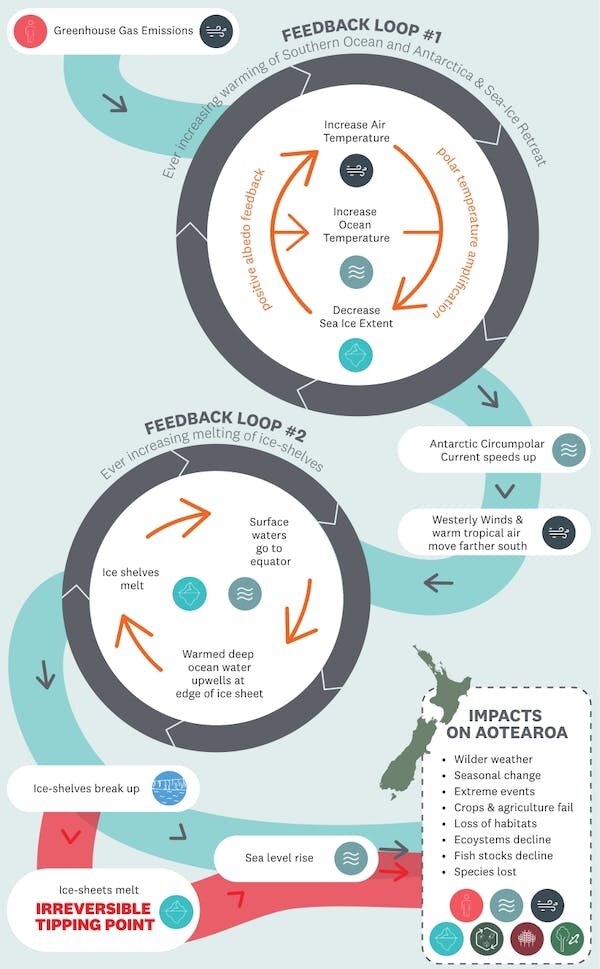
The slow-down of the Southern Ocean circulation, a dramatic drop in the extent of sea ice and unprecedented heatwaves are all raising concerns that Antarctica may be approaching tipping points.
The world has now warmed by 1.2℃ above pre-industrial levels (defined as the average temperature between 1805 and 1900) and has experienced 20cm of global sea-level rise.
Significantly higher sea-level rise and more frequent extreme climate events will happen if we overshoot the Paris Agreement target to keep warming well below 2℃. Currently, we are on track to average global warming of 3-4℃ by 2100.
While the recent Antarctic extremes are not necessarily tipping points, ongoing warming will accelerate ice loss and ocean warming, pushing Antarctica towards thresholds which, once crossed, would lead to irreversible changes—with global long-term, multi-generational repercussions and major consequences for people and the environment.
The Earth system is designed to reach equilibrium (come into balance) in response to climate heating, but the last time atmospheric levels of carbon dioxide (CO₂) were as high as they are today (423ppm) was three million years ago.
It took a millennium for the world’s climate to adjust to this. When it did, Earth’s surface was 2℃ warmer and global sea-levels were 20m higher due to Antarctic ice-sheet melting. Back then, even our earliest human ancestors were yet to evolve.
The evolution of humankind could only begin after CO₂ levels dropped below 300ppm, about 2.7 million years ago. Since then, Earth’s average temperature has fluctuated between 10℃ during ice ages and 14℃ during warmer inter-glacial periods.
During the past 10,000 years of our present inter-glacial period, Earth’s greenhouse gas thermostat has been set at 300ppm of CO₂, maintaining a pleasant average temperature of 14℃. A goldilocks climate—not too hot, not too cold—but just right for human civilization to flourish.
Current global heating is taking the Earth system across a threshold humans have never experienced, into a climate where Antarctica’s ice shelves and marine ice sheets can no longer exist and one billion people, currently living near the coast, will be drowned by rising seas.
This will be a world where wildfires, heatwaves, atmospheric rivers, extreme rainfalls and droughts—such as those we have seen globally last summer—become commonplace.
Unless we change our current emissions trajectory, this is what to expect.
By 2070, the climate over Antarctica (Te Tiri o te Moana) will warm by more than 3℃ above pre-industrial temperatures. The Southern Ocean (Te Moana-tāpokopoko-a-Tāwhaki) will be 2℃ warmer.
As a consequence, more than 45% of summer sea ice will be lost, causing the surface ocean and atmosphere over Antarctica to warm even faster as dark ocean replaces white sea ice, absorbing more solar radiation and re-emitting it as heat. This allows warm, moist air in atmospheric rivers from the tropics to penetrate further south.
If global heating is not held below 2℃, ice-sheet models show global sea-levels will rise at at an accelerating rate up to 3m per century. Future generations will be committed to unstoppable retreat of the Greenland and marine sections of the Antarctic ice sheets, causing as much as 24m of global sea-level rise.
These changes highlight the urgency for immediate and deep cuts to emissions. Antarctica has to remain a stable ice-covered continent to avoid the worst impacts of rising seas.